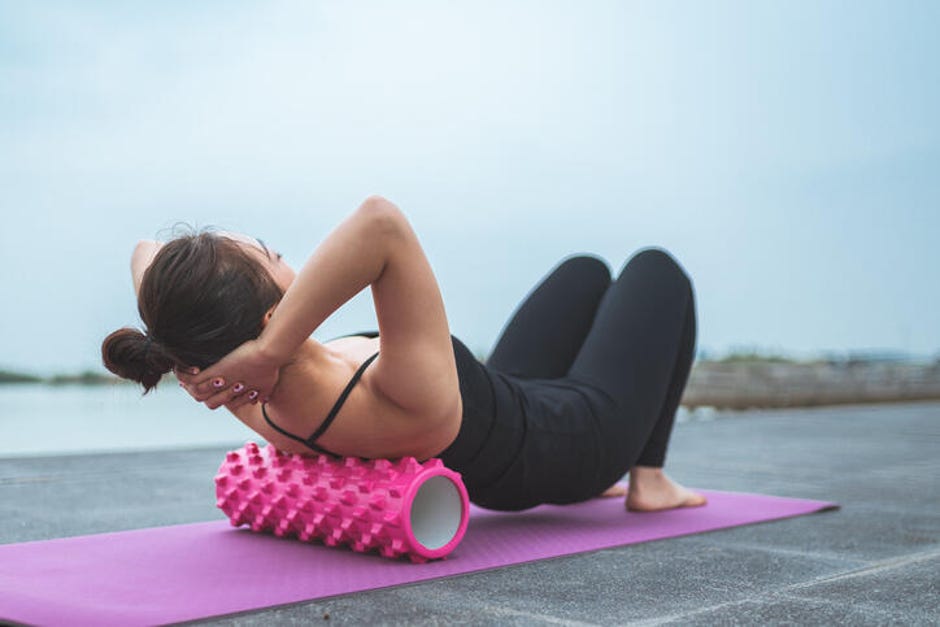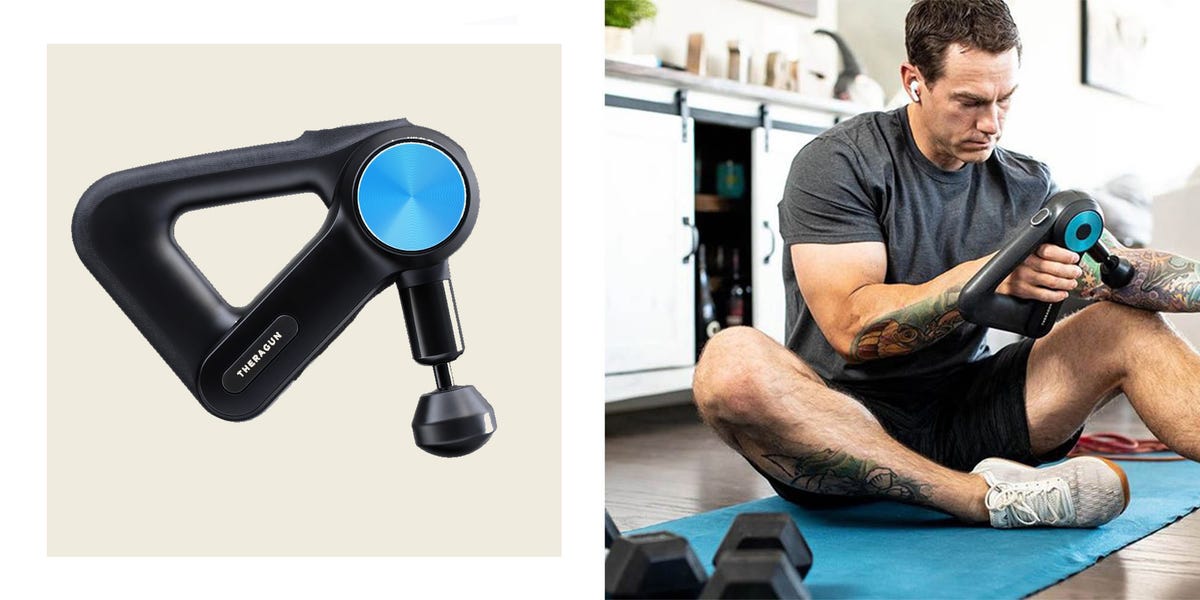Share this post:
Muscle soreness is an annoying — and often painful — side effect of new or intense exercise. Ease your soreness with one of these effective strategies.
Contents

What Causes Muscles Soreness in the First Place?
Muscle soreness after exercise (also referred to as delayed-onset muscle soreness, or DOMS) signals that you caused damage to your muscle tissue, according to the American College of Sports Medicine. When this damage, or micro-tearing, happens, your body initiates the repair process by triggering inflammation at the injured place.
Fluid accumulates in the muscles, putting extra pressure on the damaged areas, leading to that familiar sensation of tightness and pain that typically begins to develop 12 to 24 hours after your workout
While you create a little bit of damage every time you exercise, certain types of workouts are notorious for higher levels of damage and — by extension — soreness.
In particular, any workout that’s new to you, more intense than usual, or involves a lot of eccentric movements will likely cause more damage and soreness than other types of workouts.
Moderate Muscle Soreness Is a Good Thing
Some Muscle Soreness Is a Good Thing, but It Shouldn’t Last for Too Long. Normal muscle soreness should last for 2-3 days- more than 3 days signals overtraining or lack of rest!
Torn, inflamed muscles sound bad but some degree of inflammation can be an important signal for muscle growth and repair. If you help your muscles recover from the damage, they’ll likely grow back bigger and stronger, so it’s not so much that we don’t want inflammation to occur, but we want to get it under control as soon as possible.
And you probably want the soreness to go away so you can get back to moving and living pain-free.
Keep in mind that you don’t have to be sore after a workout in order for it to be effective. Soreness means damage, and damage is fine in small doses, but you don’t have to create soreness-inducing damage every time you work out. “That shouldn’t be your goal,” Dr. Schroeder says. “You don’t have to be sore everyday to know you had a good workout.”
Warm Up and Cool Down to Lessen Post-Workout Muscle Soreness
Stretching can help prevent injury and soreness. Stretching your muscles before you exercise is a good idea,focus mostly on dynamic warmup.
Cochrane review of 12 studies that looked at how stretching before or after a workout affected later muscle soreness consistently however found that stretching did not have an effect on muscle soreness within a week after a workout.
Some evidence suggests that a dynamic warmup immediately before a workout could reduce muscle soreness up to two days later, but the reduction in soreness seen in the research has been very small.
Top 6 Quick Fixes for Muscle soreness During and After Your Workout
While there aren’t any instant solutions — your muscles just need time to heal — there are some strategies you can use to ease soreness and aid recovery. Here’s what you should know.
1. Hydrate During and After Your Workout
- Staying hydrated is an important aspect of muscle recovery. Water keeps the fluids moving through your system, which eases inflammation, flushes out waste products, and delivers nutrients to your muscles
- The trouble is, it can be tricky to know if and when you’re dehydrated, as you’ll probably reach dehydration before thirst hits.
- The color of your urine provides a good indication: Medium or dark yellow signals dehydration, whereas pale yellow means you’re hydrated.
- Just be aware that taking vitamin supplements may cause your urine to look darker than usual.
2. Immediately After Your Workout, Use a Foam Roller (Self-Myofascial Release) or Massage Gun
Self-myofascial release (SMR) is a technique used to release tension in muscles and connective tissues (foam rollers, lacrosse balls, and massage sticks are common SMR tools), helping to move the fluids that accumulate in the muscle after exercise.

A review published in November 2015 in the International Journal of Sports Physical Therapy found that foam rolling may help increase range of motion and reduce DOMS. Foam rolling, as well as other types of massage, increases circulation to deliver more nutrients and oxygen to the affected area, which helps reduce swelling,pain and tenderness
If you’re interested in trying a foam roller, look for a softer version to begin with. Firmer foam rollers allow you to apply more pressure, but they can be intense if you’re unaccustomed to them. Lacrosse balls can also be handy tools to keep around, as they’re ideal for smoothing out hard-to-reach spots, like the glutes, lats, calves, and the illiotibial (IT) bands, Arent notes.
Massage guns (also called “percussive massage treatment” or “vibration therapy”) are another popular tool to promote post-workout muscle recovery.

Percussive self-massage devices work similarly to massage in general. These handheld machines deliver rapid vibrations that, when placed on your muscles, can help promote blood flow to that area. Many massage guns come with attachments of various shapes and sizes to better target different-size muscle groups.
3. Eat Within a Half Hour After an Intense Workout
By feeding your muscles the nutrients they need to repair and grow back stronger, you may be able to speed up the recovery process.
He suggests kick-starting your recovery by making sure to get 20 to 40 grams (g) of protein and 20 to 40 g of carbs into your system within 30 minutes of an intense or long workout (one that is 60 minutes or longer). (A serving of Greek yogurt with a handful of berries and a tablespoon of honey is one snack option.)
Protein is important for the amino acids needed to rebuild your muscles, while carbohydrates play a starring role in replenishing the fuel stores your muscles used up during your workout, according to a position paper on nutrient timing published in 2017 in the Journal of the International Society of Sports Nutrition.
But don’t stop at the post-workout snack; you won’t help your muscles recover if you go hungry or skimp on nutritious foods the rest of the day, Arent notes.
Prioritize meals and be sure to keep your daily protein intake fairly consistent so your tissues are fed a steady stream of amino acids throughout the day.
Recommendations vary, but the International Society of Sports Nutrition advises 1.4 to 2 g of protein per kilogram (kg) of body weight every day if you’re active, with the doses spread out evenly every three to four hours. That means if you weigh 150 pounds, you’ll need approximately 95 to 136 g of protein every day.
Fruits, vegetables, and legumes are also key for giving your body vitamins and minerals — like vitamin C and zinc — that promote healing, according to the Academy of Nutrition and Dietetics.
4. Recovery-Rest and Sleep
Rest Day or Sleep is critical for many reasons, but it’s also one of the most important components of exercise recovery, Arent says. “It may not seem like it has an immediate effect on [muscle soreness], but it can be useful for sure,” he adds.
Non–rapid eye movement (NREM) sleep, for example, increases protein synthesis (the creation of new proteins), which is needed to repair damaged muscles, according to a review in Sports Medicine.
So, the post-workout phase is no time to skimp on shut-eye. Aim to score at least seven hours of sleep, as recommended by the National Sleep Foundation.
5. Do Light Exercise The Day After a Tough Workout,
Sore muscles need to rest, but that doesn’t mean it’s best to kick your feet up and spend the day on the couch. Try to get some gentle movement through activities like restorative yoga; an easy walk, swim, or cycle; or even light resistance training. The key is to avoid doing another intense workout using the same muscle groups on consecutive days. On an effort scale of 0 to 10 (where 10 is maximum intensity), aim for an effort level of 3, Schroeder says. You want to get blood moving to the sore muscles to deliver oxygen and nutrients needed for repair — without causing more damage to the muscle tissues.
6. Avoid Drugs like painkillers (NSAIDs)
Using painkillers may sacrifice key parts of the muscle rebuilding process. Nonsteroidal anti-inflammatory drugs (NSAIDs) like Advil (ibuprofen) and Aleve (naproxen) may ease pain associated with muscle soreness, but they may also prevent your muscles from growing back bigger and stronger.
A small study published in the August 2017 issue of Acta Physiologica found that taking the maximum dosage of over-the-counter ibuprofen stalled progress during an eight-week resistance training program geared toward building muscle and strength in young adults.



